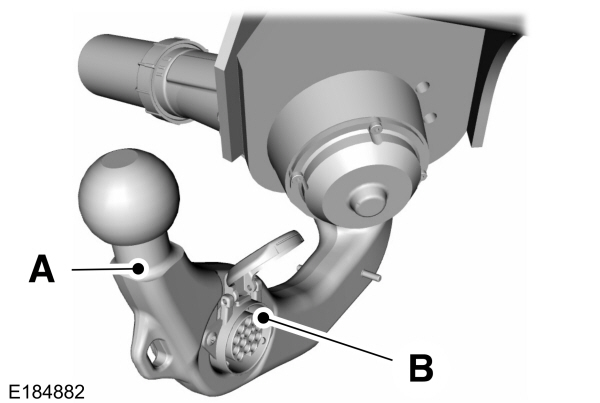This view of the Owner's Manual contains the very latest information, which may vary slightly from the printed Owner's Manual originally provided with your vehicle. It may also describe content that is not on or operates differently on your vehicle. Please consider the Owner's Manual originally provided with your vehicle as the primary source of information for your vehicle.

The information contained in this publication was correct at the time of release.In the interest of continuous development, we reserve the right to change specifications, design or equipment at any time without notice or obligation.No part of this publication may be reproduced, transmitted, stored in a retrieval system or translated into any language in any form by any means without our written permission.Errors and omissions excepted.
Copyright © 2024 Ford Motor Company
Tow Ball - Vehicles With: Retractable Tow Ball

Check that:
 WARNING:
An audible warning tone sounds when the tow ball arm is not in the fully stowed position or in proper towing position. If the audible warning tone does not sound when the tow ball arm moves or when the system switches on, do not use the tow bar. See an authorized dealer.
WARNING:
An audible warning tone sounds when the tow ball arm is not in the fully stowed position or in proper towing position. If the audible warning tone does not sound when the tow ball arm moves or when the system switches on, do not use the tow bar. See an authorized dealer. WARNING:
Do not touch the tow ball arm when it is moving.
WARNING:
Do not touch the tow ball arm when it is moving. WARNING:
Make sure there are no obstacles preventing the tow ball arm from moving.
WARNING:
Make sure there are no obstacles preventing the tow ball arm from moving. |
Note:
We recommend keeping the tow ball arm in the stowed position when you are not using it. In addition, consider local regulations and insurance terms.
Note:
Remove any adapter from the tow bar socket. Failure to do so may result in corrosion of the socket. Clean the tow bar socket regularly and make sure no dirt prevents the socket lid from closing properly.

| A B |
Swiveling the Tow Ball Arm
Note:
Do not attach any plug to the 13-pin trailer socket.
Note:
Make sure the vehicle battery has a full charge.
Note:
The vehicle has to be stationary for the tow ball arm to operate.
Note:
If something is blocking the tow ball arm during its swivel process, the system tries to reverse. If the tow ball arm stops before it is fully in towing position or stowed position, restart the swivel process by pressing the button twice.
Swiveling the Tow Ball Arm Out
Note:
If the tow ball arm does not operate, but you hear an audible double tone (low pitch followed by a high pitch), switch on the ignition for 10 seconds, and then press the brake pedal and try operating the tow ball arm again.
- Press the button. An audible double tone (low pitch followed by a high pitch) sounds to let you know the system is operating.
- Press the button again within four seconds to swivel the tow ball arm. A series of audible tones sounds and the LED flashes while the tow ball arm swivels.
- When the tow ball arm finishes swiveling, the LED stops flashing and an audible double tone (high pitch followed by a low pitch) sounds.
The tow ball arm is ready for use when it finishes swiveling into the towing position.
Swiveling the Tow Ball Arm In
Before swiveling the tow ball arm in:- Unhitch the trailer or dismantle load carriers and their attachments.
- Dismantle attachments for tracking stabilization.
- Remove the plug for the trailer power supply and the adapter from the trailer socket. Failure to do so may cause damage to the bumper when the tow ball arm swivels into its stowed position.
To start swiveling the tow ball arm in, press the swivel button twice within four seconds.
The tow ball arm swivels into the stowed position automatically.
Tow Ball Arm Fault Conditions
If the LED on the swivel button is rapidly flashing and an audible tone sequence (high pitch) sounds, repeat the swivel process. If this does not resolve the problem, see an authorized dealer.
A message may appear in the information display. See
Information Messages.
Driving with a Trailer
 WARNING:
In the event of a vehicle breakdown, disconnect the trailer before towing the vehicle.
WARNING:
In the event of a vehicle breakdown, disconnect the trailer before towing the vehicle. WARNING:
If any of the conditions below cannot be met, do not use the tow bar and have it checked by a properly trained technician. Before starting your journey, make sure that the tow ball arm is properly locked.
WARNING:
If any of the conditions below cannot be met, do not use the tow bar and have it checked by a properly trained technician. Before starting your journey, make sure that the tow ball arm is properly locked. |
Check that:
- There is a last audible low pitch tone when the locking procedure finishes.
- The tow ball arm properly locks. Make sure it does not move when jerked.
Maintenance
Note:
The towing hitch and control unit are maintenance-free. Do not grease or oil these components.
Note:
Do not attempt to service the towing hitch. Only the manufacturer should carry out repairs or dismantle the hitch.
Note:
When cleaning the vehicle with a steam jet, do not direct the high-pressure jet directly onto the swivel joint of the tow ball arm and socket. After cleaning the vehicle, unplug the connector or open the trailer socket to make sure no water entered. If water is present, dry the socket.
- Please note that Ford will not respond to individual feedback.
- Please provide detailed feedback regarding any inaccuracies in the content or any missing content in the Owner's Manual.
- Your feedback will be investigated and any necessary changes will be updated in the online Owner's Manual.
Your input is valuable in helping us improve our Owner's Manual. Thank you for taking the time to provide your feedback.
